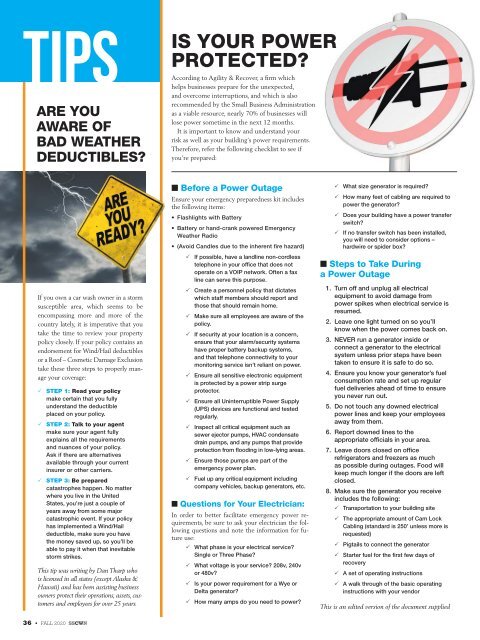FALL2020_SSCWN_web
Create successful ePaper yourself
Turn your PDF publications into a flip-book with our unique Google optimized e-Paper software.
TIPs<br />
ARE YOU<br />
AWARE OF<br />
BAD WEATHER<br />
DEDUCTIBLES?<br />
IS YOUR POWER<br />
PROTECTED?<br />
According to Agility & Recover, a firm which<br />
helps businesses prepare for the unexpected,<br />
and overcome interruptions, and which is also<br />
recommended by the Small Business Administration<br />
as a viable resource, nearly 70% of businesses will<br />
lose power sometime in the next 12 months.<br />
It is important to know and understand your<br />
risk as well as your building’s power requirements.<br />
Therefore, refer the following checklist to see if<br />
you’re prepared:<br />
If you own a car wash owner in a storm<br />
susceptible area, which seems to be<br />
encompassing more and more of the<br />
country lately, it is imperative that you<br />
take the time to review your property<br />
policy closely. If your policy contains an<br />
endorsement for Wind/Hail deductibles<br />
or a Roof – Cosmetic Damage Exclusion<br />
take these three steps to properly manage<br />
your coverage:<br />
3 STEP 1: Read your policy<br />
make certain that you fully<br />
understand the deductible<br />
placed on your policy.<br />
3 STEP 2: Talk to your agent<br />
make sure your agent fully<br />
explains all the requirements<br />
and nuances of your policy.<br />
Ask if there are alternatives<br />
available through your current<br />
insurer or other carriers.<br />
3 STEP 3: Be prepared<br />
catastrophes happen. No matter<br />
where you live in the United<br />
States, you’re just a couple of<br />
years away from some major<br />
catastrophic event. If your policy<br />
has implemented a Wind/Hail<br />
deductible, make sure you have<br />
the money saved up, so you’ll be<br />
able to pay it when that inevitable<br />
storm strikes.<br />
This tip was writing by Dan Tharp who<br />
is licensed in all states (except Alaska &<br />
Hawaii) and has been assisting business<br />
owners protect their operations, assets, customers<br />
and employees for over 25 years.<br />
■ Before a Power Outage<br />
Ensure your emergency preparedness kit includes<br />
the following items:<br />
• Flashlights with Battery<br />
• Battery or hand-crank powered Emergency<br />
Weather Radio<br />
• (Avoid Candles due to the inherent fire hazard)<br />
3 If possible, have a landline non-cordless<br />
telephone in your office that does not<br />
operate on a VOIP network. Often a fax<br />
line can serve this purpose.<br />
3 Create a personnel policy that dictates<br />
which staff members should report and<br />
those that should remain home.<br />
3 Make sure all employees are aware of the<br />
policy.<br />
3 If security at your location is a concern,<br />
ensure that your alarm/security systems<br />
have proper battery backup systems,<br />
and that telephone connectivity to your<br />
monitoring service isn’t reliant on power.<br />
3 Ensure all sensitive electronic equipment<br />
is protected by a power strip surge<br />
protector.<br />
3 Ensure all Uninterruptible Power Supply<br />
(UPS) devices are functional and tested<br />
regularly.<br />
3 Inspect all critical equipment such as<br />
sewer ejector pumps, HVAC condensate<br />
drain pumps, and any pumps that provide<br />
protection from flooding in low-lying areas.<br />
3 Ensure those pumps are part of the<br />
emergency power plan.<br />
3 Fuel up any critical equipment including<br />
company vehicles, backup generators, etc.<br />
■ Questions for Your Electrician:<br />
In order to better facilitate emergency power requirements,<br />
be sure to ask your electrician the following<br />
questions and note the information for future<br />
use:<br />
3 What phase is your electrical service?<br />
Single or Three Phase?<br />
3 What voltage is your service? 208v, 240v<br />
or 480v?<br />
3 Is your power requirement for a Wye or<br />
Delta generator?<br />
3 How many amps do you need to power?<br />
3 What size generator is required?<br />
3 How many feet of cabling are required to<br />
power the generator?<br />
3 Does your building have a power transfer<br />
switch?<br />
3 If no transfer switch has been installed,<br />
you will need to consider options –<br />
hardwire or spider box?<br />
■ Steps to Take During<br />
a Power Outage<br />
1. Turn off and unplug all electrical<br />
equipment to avoid damage from<br />
power spikes when electrical service is<br />
resumed.<br />
2. Leave one light turned on so you’ll<br />
know when the power comes back on.<br />
3. NEVER run a generator inside or<br />
connect a generator to the electrical<br />
system unless prior steps have been<br />
taken to ensure it is safe to do so.<br />
4. Ensure you know your generator’s fuel<br />
consumption rate and set up regular<br />
fuel deliveries ahead of time to ensure<br />
you never run out.<br />
5. Do not touch any downed electrical<br />
power lines and keep your employees<br />
away from them.<br />
6. Report downed lines to the<br />
appropriate officials in your area.<br />
7. Leave doors closed on office<br />
refrigerators and freezers as much<br />
as possible during outages. Food will<br />
keep much longer if the doors are left<br />
closed.<br />
8. Make sure the generator you receive<br />
includes the following:<br />
3 Transportation to your building site<br />
3 The appropriate amount of Cam Lock<br />
Cabling (standard is 250’ unless more is<br />
requested)<br />
3 Pigtails to connect the generator<br />
3 Starter fuel for the first few days of<br />
recovery<br />
3 A set of operating instructions<br />
3 A walk through of the basic operating<br />
instructions with your vendor<br />
This is an edited version of the document supplied<br />
36 • FALL 2020

















